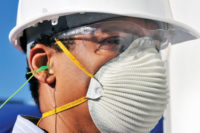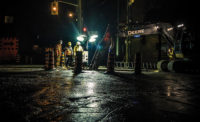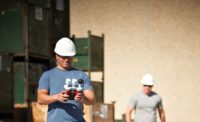Evaluate your respiratory exposures from all angles

The CDC reports that PPE is used on a regular basis by approximately 20 million workers in the U.S.1. Particular focus should be placed on proper respiratory protection for onsite work processes—which remains number four on the list of OSHA’s 2015 Top Ten Most Frequently Cited Violations2 for the fifth consecutive year.
Understanding your potential worksite respiratory risks is fundamental if you want to foster a thriving and safe work environment. If you are in high-risk industry such as oil and gas extraction and transportation, it’s critical to move beyond a “one-size-fits-all” mentality regarding PPE in general, and specifically respirators. You should proactively identify potential hazards and choose the best respirator far in advance of an incident.
If you accept and apply the literal interpretation of the term “one size fits all” to respirators you could be creating a life-threatening danger. A word to the wise: recognize the harm this mentality can inflict and replace it with the understanding that each worker is different. This affects the way a respirator is fitted and ultimately used. You want to be totally confident that your workers are adequately guarded against life-threatening conditions. This means educating yourself and anyone else involved in selecting respiratory protection to understand the cautions, limitations and use restrictions of all the respirator models you are considering.
To meet the challenge of equipping your employees with the best respirator for their unique work exposures and maximizing their protection you should follow the “three Ps.”
1. Prepare to mitigate risks
The first and most crucial step in selecting the proper respirator for a specific worksite is to identify all areas of risk by conducting a risk assessment. This assessment should include an initial analysis and be re-administered when new processes and equipment are introduced. It’s the responsibility of company leadership to be aware of any changing regulations or processes that may trigger and require a new risk assessment be conducted at their worksite.
Evaluating the situation from multiple angles not only aids in determining the potential hazards workers may encounter, but also intelligently informs which respirator may be required for specific worksite conditions. To ensure that the risk assessment is conducted to in the most comprehensive manner possible, health and safety mangers should consider hiring an industrial hygienist to evaluate workplace conditions. The hygienist should specialize in the industry in question and possess a valid certificate and meet all licensing requirements. In conjunction with the industrial hygienist’s report, company leaders can perform their own risk assessment to further ensure all priority areas are mapped and accounted.
2. Protection at the highest level
One main takeaway from the initial risk assessment will be the identification of potential worksite hazards, including the presence of gases that may exceed recommended concentration limits According to OSHA, employers should "provide the respirators which are applicable and suitable for the purpose intended."3 As the exposure’s duration and concentration in parts per million (ppm) are linked to a worker’s health, companies must educate themselves and their workforce on which respirator types correspond to the respective hazardous gases present.
As an example, for hydrogen sulfide (H2S) exposure concentrations, the following respirator types are suggested:
• 0-10 ppm: No respirator is needed, below REL.
• 10-100 ppm: Powered Air-Purifying Respirator (PAPR), Full Face Mask Cartridge Respirator, or Self-Contained Breathing Apparatuses (SCBA).
• 100-100,000 ppm: SCBA or Supplied Air in positive pressure mode.
Companies can refer to the NIOSH Pocket Guide to Chemical Hazards to view similar regulation charts for additional gas/dust particles.
3. Provide the proper fit
While the risk assessment is absolutely necessary to identifying the worksite’s demands, an additional evaluation of the workers themselves should be considered, as the final decision to wear the respirator ultimately rests on their shoulders.
In OSHA's standards on respiratory protection on fit testing, section 1910.134(f) states, “the employee must be fit tested with the same make, model, style, and size of respirator that will be used." It is mandated that respirators go through rigorous tests, such as a qualitative fit test (QLFT) or quantitative fit test (QNFT) for tight-fitting facepiece respirators. Upon passing these tests, the respirator is set to its NIOSH-approved configuration before field use is allowed. For loose-fitting respirators, an inspection is conducted to determine air flow is not inhibited and positive-pressure is maintained within the hood.
For companies seeking to safeguard their workers against potentially hazardous contaminants and maximize safety, the powerful combination of a risk and workforce assessments will provide strong guidance to the proper respirator.
Knowledge is the best defense
Companies that choose to enact the guidelines set forth in “The three P’s” will help ensure they are selecting the right respirators for their workers and worksite conditions. In any situation, knowledge is the best defense against the unexpected.
2 www.osha.gov/Top_Ten_Standards.html
3 www.osha.gov/pls/oshaweb/owadisp.show_document?p_table=STANDARDS&p_id=12716
Looking for a reprint of this article?
From high-res PDFs to custom plaques, order your copy today!






